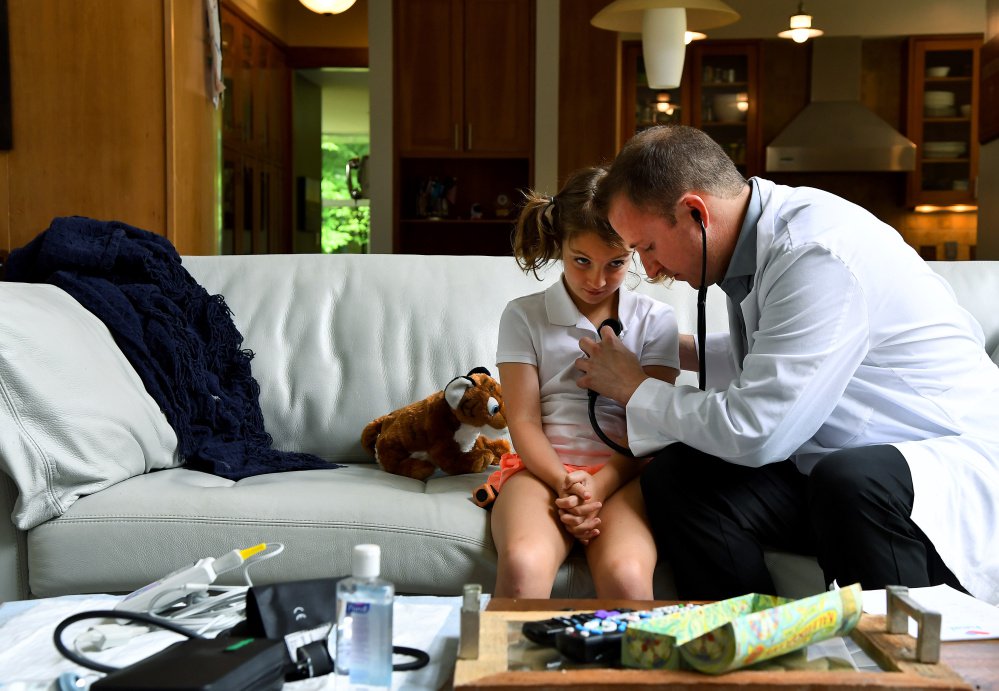Alison Mintzer and her family were on a flight from New York to Los Angeles when her daughter complained that she felt sick. By the time they landed, Mintzer’s normally uncomplaining 6-year-old said that her neck and ears hurt. When a fever soon followed, it was enough to convince her parents that she needed to see a doctor.
Thousands of miles from their pediatrician, and unable to find one quickly in L.A., Mintzer didn’t know what to do. Then a family friend suggested an app called Heal that could use new technology to drum up a relic from the past: doctors who make house calls.
Once upon a time, a visit with the doctor meant welcoming one into your home, rather than heading out to a clinic or hospital waiting room. But around the 1960s, the house call fell out of favor as doctors’ offices sought to become more efficient, and the doctor-patient relationship changed from “Marcus Welby” to something less personal with the rise of hospitals and modern insurance plans.
Now, however, the trend for on-demand service in the age of Uber could revive the house call. Services such as Heal – which launched in Washington, D.C., in June after operating in California since 2014 – and competitors such as Pager and Curbside Care are expanding their footprints across the country. And research suggests that house calls can provide a better standard of care for some patients than a hospital visit.
COSTS CAN DROP
A University of Southern California study of a house call program in the state found that hospitalization rates dropped for patients who were enrolled in the program for six months: Of 1,000 patients, 96 were hospitalized after being enrolled, down from 159 before the program.
Costs can also drop, since patients can avoid hospital visits. A 2013 Brookings Institution report said a Department of Veterans Affairs analysis of its home-based care program found a “25 percent reduction in hospital admissions, a 36 percent reduction in hospital days, and a 13 percent reduction in combined costs.”
The chief executive of Heal, Nick Desai, co-founded the start-up with his wife, Renee Dua, a physician. Their own parental trip to the emergency room inspired the service after the couple, unable to contact their regular pediatrician, sat in an emergency room for seven hours with their feverish 3-month-old son.
“My wife turned to me and said, ‘There’s got to be a better way,’” Desai recalled. So Heal was born – a service that can work with patients’ insurance. For those without insurance, a visit costs up to $99.
“Our number one, main goal is that, five years from now, you won’t have to go to the doctor’s office,” Desai said.
That’s certainly been the case for Tony Rogers, a 57-year-old Heal patient in Orange County, California, whose health problems have made it progressively more difficult for him to leave his home. Just after Christmas in 2015, he decided he’d paid his last visit to the doctor he’d seen for 35 years, because it was too hard to get to the office. His sister found out about Heal online and recommended it to him.
CONVENIENCE A BIG PLUs
Rogers said it has been a revelation.
He can now see a doctor on his front porch; he even had an ultrasound taken in his own bed. When he received a diabetes diagnosis, his physician took an immediate audit of his kitchen, pointing out which foods were fine to eat and which weren’t. She was also able to look at the laundry detergent he was using and recommend brands that would not irritate his skin.
“She told me, ‘This is good, this is not.’ It was a really nice teaching experience,” Rogers said.
For others, the fact that Heal appointments can easily fit into their lives is key. Barbara Bennett, director of the D.C. market for Heal, recently used the service to schedule a last-minute physical at her Great Falls, Virginia, home for her daughter, Claire. An appointment with her normal pediatrician would have required waiting at least a week – past the deadline to submit forms for summer camp. With Heal, Bennett scheduled a same-day appointment.
The convenience was a big plus, she said.
“I didn’t feel drained. I hadn’t sat in traffic. I just picked up and kept going on with the day,” she said.
And the forms? They arrived that night, allowing her to turn everything in on time.
There are many things Heal and other on-demand doctor apps can’t deliver. For one, apps are not a substitute for emergency care. If patients input symptoms into Heal that indicate an emergency, they will be directed to call 911.
At a patient’s home, doctors can provide a range of standard care but can’t cart around heavier or more complex equipment, such as an MRI machine. Nor can they do something major, such as surgery or procedures that require highly specialized equipment or expertise.
Heal also isn’t a solution to providing care in places where doctors are scarce, as its current markets are heavily urban.
Desai said Washington is an attractive market in part because of its density and its transient population, which means there are probably a lot of people in the area who don’t have a regular primary-care doctor.
Copy the Story LinkSend questions/comments to the editors.



Success. Please wait for the page to reload. If the page does not reload within 5 seconds, please refresh the page.
Enter your email and password to access comments.
Hi, to comment on stories you must . This profile is in addition to your subscription and website login.
Already have a commenting profile? .
Invalid username/password.
Please check your email to confirm and complete your registration.
Only subscribers are eligible to post comments. Please subscribe or login first for digital access. Here’s why.
Use the form below to reset your password. When you've submitted your account email, we will send an email with a reset code.